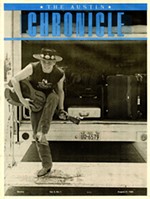Road TRIPping
Austin has the fifth-highest rate of traffic fatalities in the nation, according to a highway lobbyist organization.
By Lee Nichols, Fri., Jan. 11, 2002
In its report (available online at www.tripnet.org), TRIP analyzed National Highway Traffic Safety Administration data from 2000 to identify the deadliest urban areas in which to drive and used their findings to recommend ways to make roadways safer. Worst in the nation were three Florida metropolitan areas -- Orlando (the highest at 17.2 deaths per 100,000 residents), Tampa-St. Petersburg, and West Palm Beach, followed by Memphis, Tenn., and Austin (14.2 fatalities per 100,000). To derive its statistics, TRIP identified a certain county or counties associated with a particular city, and then divided its population by the number of traffic fatalities in that area. Although TRIP factored in as many as six surrounding counties when scrutinizing other cities, their definition of "Austin" only included Travis County. No other Texas city made the top 10.
"Land [population] density does not appear to be a significant factor in regional traffic safety," TRIP concluded. The organization promotes what it calls "Quality Growth" -- a philosophy that stringently rejects any governmental efforts to steer urban growth or to discourage the building of suburbs. "We're just mentioning density because it's a public policy issue, whether it's Smart or Quality Growth," said Paul Haaland, one of the TRIP analysts who wrote the report. "We just couldn't say convincingly that density had an effect one way or the other."
Perhaps TRIP's report is most noteworthy for what it doesn't recommend -- namely, that people can get out of their cars and into mass transit. Meanwhile, its safety recommendations seem relatively obvious, and a few -- installing bike lanes, curb extensions, and sidewalks, for examples -- are right in step with Smart Growth.
"The recommendations are standard for just about every highway department," said Texas Dept. of Transportation spokesman John Hurt. "Every recommendation they made we have either done, or are planning to do. Putting barrier walls between highway lanes, creating turn lanes -- we are doing those things everywhere."
Austan Librach, the director of Austin's Transportation, Planning, and Sustainability Dept., questioned the premise of TRIP's report. "We should talk about accidents rather than fatalities," he said. "If a school bus full of kids gets hit, that would bump up a city's numbers." When deciding where to install new signals or changes in a roadway, Librach said, his department places more emphasis on accidents than deaths. "We may be high in accidents as well. But I think there are some extraordinary reasons here, and [I-35] is particularly deadly. This is a particularly congested stretch ... and may be the most congested in the country." (Oddly, and seemingly counter to the interest of road-builders, the report said that high congestion "might actually reduce some fatalities by slowing traffic.")
TRIP's anti-Smart Growth approach also runs counter to what Librach and many other Austin city officials endorse. "With Smart Growth, we want to reduce demand for those roads by having alternative transit, bikes, and walking as well as [light] rail," he said, adding that higher-density population along transit corridors with bus and rail lines might accomplish this goal.
Both Librach and the Austin Police Dept. were also a bit put off by TRIP's use of Travis County to represent Austin. Of Travis' 115 total fatalities in 2001, only 77 (that's 67%) took place within city limits, though some 81% of the county population lives in the city. Meanwhile, Travis Co. Sheriff's Office spokesperson Roger Wade said the county is "taking a proactive stance" on traffic safety by creating seven new positions for deputies specifically assigned to traffic detail.
Got something to say on the subject? Send a letter to the editor.








